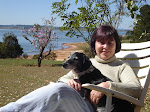 The original image of the brood was slide, but I digitalized it. A foto original das corujinhas era slide, mas eu digitalizei.
The original image of the brood was slide, but I digitalized it. A foto original das corujinhas era slide, mas eu digitalizei.More or less thirty years ago, after my house was built, we found a family of barn-owls (a mother and five owlets) in the ceiling. They were very noisy and we need to dislodge them. Unfortunatelly the frightened mother flew away. A mason takes them to his home. I did not know what happened to the owlets after that... I had no idea to take them to the Zoo...
Mais ou menos há trinta anos, logo depois que minha casa foi construída, encontramos uma família de suindaras (a mãe e cinco filhotes) no forro de casa. Elas faziam muito barulho e precisamos desalojá-las. Infelizmente, a mãe assustada abandonou os filhotes e um pedreiro que trabalhava na obra levo-as para a sua casa. Não soube mais o que aconteceu com eles... Na época não tive idéia de levá-los a um Zoológico....
Barn-owls (family Tytonidae) knows also as Masked Owl, are one of the two families of owls, the other being the typical owls, Strigidae. They are medium to large sized owls with large heads and characteristic heart-shaped faces. They have long, strong legs with powerful talons. They also differ from Strigidae in structural details relating in particular to the sternum and feet. Tyto alba is found almost anywhere in the world outside Antarctica.
A coruja-das-torres ou Suindara, (Tyto alba) Tytonidae (conhecidas popularmente por suindaras) é um coruja da família dos titonídeos, também conhecida pelo nome de coruja-da-igreja, coruja-branca e suindara. Elas são de tamanho médio para grande, com grandes cabeças no formato característico de "coração". Elas são encontrada em praticamente todos os habitats e habitam cavernas, telhados de celeiros, prédios e torres de igrejas. É uma das aves com maior distribuição no planeta, com exceção da Antártida.
A coruja-das-torres ou Suindara, (Tyto alba) Tytonidae (conhecidas popularmente por suindaras) é um coruja da família dos titonídeos, também conhecida pelo nome de coruja-da-igreja, coruja-branca e suindara. Elas são de tamanho médio para grande, com grandes cabeças no formato característico de "coração". Elas são encontrada em praticamente todos os habitats e habitam cavernas, telhados de celeiros, prédios e torres de igrejas. É uma das aves com maior distribuição no planeta, com exceção da Antártida.


Umas férinhas!!!!
ReplyDeleteOh Sonia, that owl on the left looks very weird!
ReplyDeleteHis neck is very strange.
I've never seen an owl in the flesh before - they are few and far between here.
Sonia, this is an interesting image, they are so odd but it's nice to see them!
ReplyDeleteHave a very good Sunday!
WOW! I've never seen an Owl that looked like these do. I've seen the other regular Owls on occasion---once, a long time ago, a VERY VERY Large Owl was sitting in the middle of a country road at night....But these look quite different, don't they. Amazing that you got this picture, my dear.
ReplyDeleteUnusual owls...
ReplyDeleteInteresting reading.
Tivemos uma coruja aqui em casa durante algum tempo, na jabuticabeira. Depois ela sumiu. A Lu adorava registrar o vôo dela, dizia que ela flutuava pelo ar. Certa noite ela pousou na janela do nosso quarto e ficou lá durante um bom tempo, mexendo a cabeça de um lado para o outro. Depois disso desapareceu. Sorte que ainda não tínhamos o Patrick e sua voracidade de caçador. Grande abraço
ReplyDeleteSonia, as criancas por aqui iriam adorar ter uma coruja dessas. Elas sao agressivas? Nao sei, nao tenho idéia.
ReplyDeleteQuanto vc nao ter tido idéias de levá-las a um Zoo, às vezes nos acontece, só depois do caso passado, ai pensamos com mais calma sobre a coisa.
Boa semana querida.
Um grande beijo
I remember the barn owls from living in the midwestern US years ago. I've never seen so many in one place though! Thanks for sharing.
ReplyDeleteSempre tive uma certa aversão (ou medo) pelas corujas sem razão, na verdade as conheço pouco. Na verdade elas são fascinantes, inspiram mistério!
ReplyDeleteBeijos e uma boa semana para você.
Funny and surprising look! ... but I can well understand that to listen to them during night must not have been very pleasant!
ReplyDeleteSonia, passei aqui para te deixar um beijo de fim de ano. A partir de amanhã fico sem net e nao sei ainda quando voltarei a me conectar. Foi muito bom conhecer seus blogs e mais ainda vc. Se encontrar com a Bel, diga que mandei um beijo para ela.
ReplyDeleteBeijo grande
Leandro
They are lovely even in their youthful geekiness. What a find even if in the wrong place.
ReplyDeletescary!
ReplyDeleteWow, what a photo! Amazing.
ReplyDeleteVery strange for us!!
ReplyDeleteOwls are soft and lovely birds - in the UK you would have to get permission to rehouse owls.
ReplyDeleteGrande familia Sonia, uma delicia ver isto, mesmo abandonados pela mae devem ter permanecido juntos!
ReplyDeleteSonia they are amazing! I am pretty sure these are the owls that we had roosting in our tack room connected to the barn when I was in high school years, and I mean years ago.
ReplyDelete